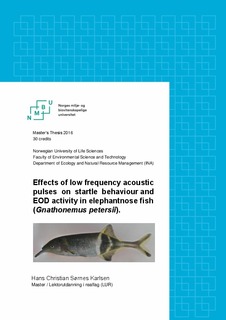| dc.contributor.advisor | Karlsen, Hans Erik | |
| dc.contributor.advisor | Haugen, Thrond Oddvar | |
| dc.contributor.author | Karlsen, Hans Christian Sørnes | |
| dc.coverage.spatial | Norway, Drøbak | nb_NO |
| dc.date.accessioned | 2016-11-21T11:51:00Z | |
| dc.date.available | 2016-11-21T11:51:00Z | |
| dc.date.issued | 2016-11-21 | |
| dc.identifier.uri | http://hdl.handle.net/11250/2422115 | |
| dc.description.abstract | The sensory system initiating C-response and electric organ discharge (EOD) response in the hearing specialist elephantnose fish was studied in an experimental swing chamber set-up. The swing chamber is specially designed for producing controlled low frequency acoustic stimulus waveforms. The waveforms studied in the experiments were single cycle sinusoids of initial acoustic pressure and particle acceleration in the frequency range 10 Hz to 30 Hz, and mimicked key components in the acoustic signature of charging predatory fish attacks. The aim of the study was to reveal how initial acoustic pressure and particle acceleration trigger the inner ear sensory system in elephantnose fish to produce acoustic EOD- and C-responses. Acoustic startle behaviour was found to be optimally triggered by a combination of acoustic particle acceleration and compression, and very rarely by the same level of acoustic particle acceleration and rarefaction. Startle behaviours were highly directional, and this was ascribed to inner ear detection and coding of the direction of the initial particle acceleration. In the centre of the test chamber, acoustic startle behaviours were triggered by the particle acceleration component alone, but at significantly lower probability than when combined with compression. Startle behaviours observed in response to the low frequency stimuli greatly extended the known audible hearing range in elephantnose fish. Contrary to general opinion within the field of fish hearing, it was shown that acoustic pressure sensitivity is of behavioural relevance at very low sonic and infrasonic frequencies. The results of the study support the view that acute acoustic pressure sensitivity evolved independently several times in fish as adaptations to perform differentiated and more adaptable escapes from striking predatory attacks. EOD-responses were produced by the acoustic stimuli, and were significantly stronger to compression stimuli than to rarefaction stimuli. Why elephantnose fish emit a strong burst of EODs during acoustic startle behaviour is unclear, but may perhaps be as a distraction of electro-sensitive predators. | nb_NO |
| dc.description.sponsorship | Finn Jørgen Walvigs Foundation | nb_NO |
| dc.language.iso | eng | nb_NO |
| dc.publisher | Norwegian University of Life Sciences, Ås | |
| dc.rights | Navngivelse 3.0 Norge | * |
| dc.rights | Navngivelse-Ikkekommersiell 3.0 Norge | * |
| dc.rights.uri | http://creativecommons.org/licenses/by-nc/3.0/no/ | * |
| dc.subject | Fish behaviour | nb_NO |
| dc.subject | Fish hearing | nb_NO |
| dc.subject | Startle behaviour | nb_NO |
| dc.subject | EOD response | nb_NO |
| dc.title | Effects of low frequency acoustic pulses on startle behaviour and EOD activity in elephantnose fish (Gnathonemus petersii) | nb_NO |
| dc.type | Master thesis | nb_NO |
| dc.subject.nsi | VDP::Agriculture and fishery disciplines: 900::Fisheries science: 920::Other fisheries disciplines: 929 | nb_NO |
| dc.source.pagenumber | 70 | nb_NO |
| dc.description.localcode | M-ECOL | nb_NO |

